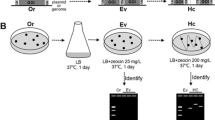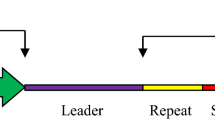Abstract
Site-specific gene modifications in cells are initiated by the introduction of exogenous DNA. We used a recently established cell assay to compare the ability of DNA donors to induce a single point mutation that converts a target gene encoding blue fluorescent protein (BFP) into expressing green fluorescent protein (GFP). In a chromosomal assay with cells stably expressing BFP, we showed that fluorescently labeled single-stranded oligonucleotides and a donor plasmid cotranscribing a red fluorescent protein provide similar efficiencies in triggering BFP–GFP conversions. In transient cotransfections, an isogenic donor plasmid comprising a nonfunctional GFP gene yielded a greater efficiency for the conversion of the BFP target gene than a nonisogenic donor, and all plasmid donors were superior to oligonucleotides.



Similar content being viewed by others
References
Alwin S, Gere MB, Guhl E, Effertz K, Barbas CF 3rd, Segal DJ, Weitzman MD, Cathomen T (2005) Custom zinc-finger nucleases for use in human cells. Mol Ther 12:610–617
Baumann P, West SC (1998) Role of the human RAD51 protein in homologous recombination and double-stranded-break repair. Trends Biochem Sci 23:247–251
Bertoni C (2005) Oligonucleotide-mediated gene editing for neuromuscular disorders. Acta Myol 24:194–201
Kolb AF, Coates CJ, Kaminski JM, Summers JB, Miller AD, Segal DJ (2005) Site-directed genome modification: nucleic acid and protein modules for targeted integration and gene correction. Trends Biotechnol 23:399–406
Laible G (2009) Enhancing livestock through genetic engineering—recent advances and future prospects. Comp Immunol Microbiol Infect Dis 32:123–137
Laible G, Alonso-Gonzalez L (2009) Gene targeting in livestock animals: current status and emerging concepts. Biotechnol J 4:1278–1292
Laible G, Wagner S, Alderson J (2006) Oligonucleotide-mediated gene modification and its promise for animal agriculture. Gene 366:17–26
Leclerc X, Danos O, Scherman D, Kichler A (2009) A comparison of synthetic oligodeoxynucleotides, DNA fragments and AAV-1 for targeted episomal and chromosomal gene repair. BMC Biotechnol 9:35
Ludtke JJ, Zhang G, Sebestyen MG, Wolff JA (1999) A nuclear localization signal can enhance both the nuclear transport and expression of 1 kb DNA. J Cell Sci 112(Pt 12):2033–2041
Nickerson HD, Colledge WH (2003) A comparison of gene repair strategies in cell culture using a lacZ reporter system. Gene Ther 10:1584–1591
Olsen PA, Solhaug A, Booth JA, Gelazauskaite M, Krauss S (2008) Cellular responses to targeted genomic sequence modification using single-stranded oligonucleotides and zinc-finger nucleases. DNA Repair (Amst) 8:298–308
Parekh-Olmedo H, Kmiec EB (2007) Progress and prospects: targeted gene alteration (TGA). Gene Ther 14:1675–1680
Reiss B (2003) Homologous recombination and gene targeting in plant cells. Int Rev Cytol 228:85–139
Sommer JR, Alderson J, Laible G, Petters RM (2006) Reporter system for the detection of in vivo gene conversion: changing colors from blue to green using GFP variants. Mol Biotechnol 33:115–122
Suzuki T (2008) Targeted gene modification by oligonucleotides and small DNA fragments in eukaryotes. Front Biosci 13:737–744
te Riele H, Maandag ER, Berns A (1992) Highly efficient gene targeting in embryonic stem cells through homologous recombination with isogenic DNA constructs. Proc Natl Acad Sci USA 89:5128–5132
Acknowledgments
We are grateful to Peter Beetham and Greg Gocal (Cibus LLC, San Diego, CA) for providing us with fluorescently labeled oligonucleotides and Jeff Sommer (North Carolina State University, Raleigh, NC) for supplying us with CHO-BFP cell lines. We would also like to thank an anonymous reviewer for valuable experimental advice. This study was funded by the New Zealand Foundation for Research and Technology.
Author information
Authors and Affiliations
Corresponding author
Rights and permissions
About this article
Cite this article
Wagner, S., McCracken, J., Cole, S. et al. DNA Oligonucleotides and Plasmids Perform Equally as Donors for Targeted Gene Conversion. Biochem Genet 48, 897–908 (2010). https://doi.org/10.1007/s10528-010-9370-z
Received:
Accepted:
Published:
Issue Date:
DOI: https://doi.org/10.1007/s10528-010-9370-z




